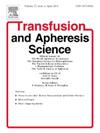Evaluating strategic blood donor recruitment initiatives: Insights from King Fahd armed forces hospital experience
IF 1.4
4区 医学
Q4 HEMATOLOGY
引用次数: 0
Abstract
Background & aims
Ensuring a safe and sufficient blood supply requires effective recruitment strategies, particularly in post-pandemic contexts. This study examines the transition at King Fahd Armed Forces Hospital (KFAFH) from a predominantly patient-related donor base to a focus on volunteer-based mobile and app-facilitated donations. It evaluates key factors influencing this shift and explores the potential for applying this model nationally.
Methods
A quasi-experimental retrospective analysis was conducted using KFAFH donation records from 2014 to 2024. Donors were categorized by recruitment type (patient-related, military, mobile, app-based, staff, and other) and compared based on age, gender, first-time vs. repeat status, donation frequency, and infectious disease testing (IDT) outcomes. Donor eligibility criteria and donation intervals were also analyzed. A SWOT analysis evaluated the operational aspects of mobile campaigns, including recruitment strategies, collection sites, and incentive usage.
Results
From 2021–2024, mobile and app-based campaigns significantly increased voluntary donations, while patient-related donations decreased by over 50 %. Mobile donors were predominantly repeat donors aged 25–40, with a higher male participation rate. IDT reactivity rates were lower in mobile donors compared to patient-related donors. Mobile drives—held at businesses, schools, and community centers—were supported by targeted outreach, recurring events, and non-monetary incentives. The program demonstrated operational strengths but encountered logistical and resource challenges.
Conclusions
Mobile and technology-driven recruitment significantly increased voluntary donations and reduced dependence on patient-related donations at KFAFH. This model shows promise as a replicable strategy for building a more resilient and sustainable national blood supply system.
评估献血者招募战略举措:法赫德国王武装部队医院经验的见解
背景,目的确保安全和充足的血液供应需要有效的招募战略,特别是在大流行后的背景下。本研究考察了法赫德国王武装部队医院(KFAFH)从以患者为主的捐赠基础向以志愿者为基础的移动和应用程序促进捐赠的转变。它评估了影响这一转变的关键因素,并探讨了在全国范围内应用这一模式的潜力。方法对2014 - 2024年KFAFH捐赠记录进行准实验回顾性分析。捐赠者按招募类型(患者相关、军事、移动、基于应用程序、工作人员和其他)进行分类,并根据年龄、性别、首次与重复状态、捐赠频率和传染病检测(IDT)结果进行比较。还分析了供体资格标准和捐赠间隔。SWOT分析评估了移动营销活动的运营方面,包括招聘策略、收集网站和激励使用。结果从2021年到2024年,基于移动和应用程序的活动显著增加了自愿捐赠,而与患者相关的捐赠减少了50%以上 %。流动捐助者主要是25-40岁的重复捐助者,男性参与率较高。与患者相关的献血者相比,流动献血者IDT反应率较低。在企业、学校和社区中心举行的移动驱动活动得到了有针对性的推广、经常性活动和非货币激励措施的支持。该计划展示了操作优势,但遇到了后勤和资源方面的挑战。结论移动和技术驱动的招募显著增加了KFAFH的自愿捐赠,减少了对患者相关捐赠的依赖。这种模式有望成为一种可复制的战略,用于建设一个更具弹性和可持续性的国家血液供应系统。
本文章由计算机程序翻译,如有差异,请以英文原文为准。
求助全文
约1分钟内获得全文
求助全文
来源期刊
CiteScore
3.60
自引率
5.30%
发文量
181
审稿时长
42 days
期刊介绍:
Transfusion and Apheresis Science brings comprehensive and up-to-date information to physicians and health care professionals involved in the rapidly changing fields of transfusion medicine, hemostasis and apheresis. The journal presents original articles relating to scientific and clinical studies in the areas of immunohematology, transfusion practice, bleeding and thrombotic disorders and both therapeutic and donor apheresis including hematopoietic stem cells. Topics covered include the collection and processing of blood, compatibility testing and guidelines for the use of blood products, as well as screening for and transmission of blood-borne diseases. All areas of apheresis - therapeutic and collection - are also addressed. We would like to specifically encourage allied health professionals in this area to submit manuscripts that relate to improved patient and donor care, technical aspects and educational issues.
Transfusion and Apheresis Science features a "Theme" section which includes, in each issue, a group of papers designed to review a specific topic of current importance in transfusion and hemostasis for the discussion of topical issues specific to apheresis and focuses on the operators'' viewpoint. Another section is "What''s Happening" which provides informal reporting of activities in the field. In addition, brief case reports and Letters to the Editor, as well as reviews of meetings and events of general interest, and a listing of recent patents make the journal a complete source of information for practitioners of transfusion, hemostasis and apheresis science. Immediate dissemination of important information is ensured by the commitment of Transfusion and Apheresis Science to rapid publication of both symposia and submitted papers.

 求助内容:
求助内容: 应助结果提醒方式:
应助结果提醒方式:


